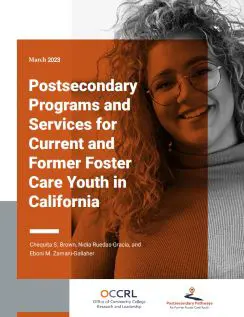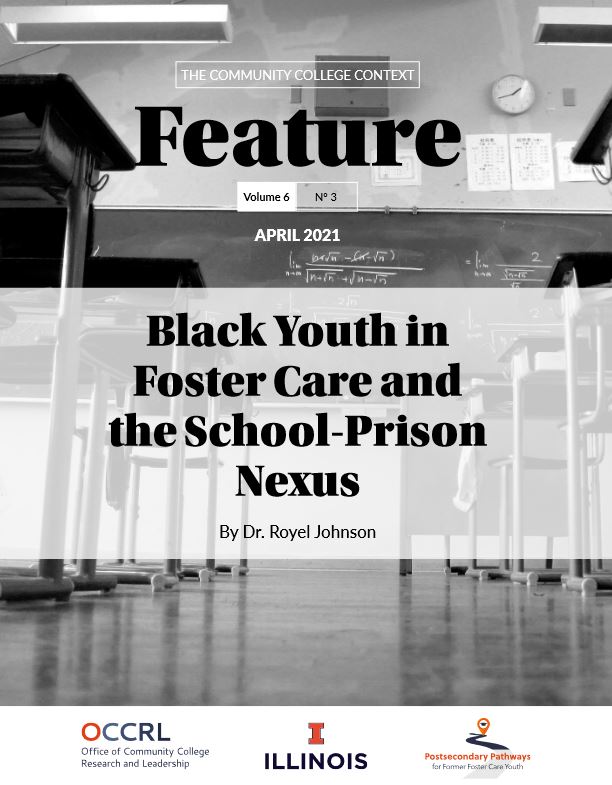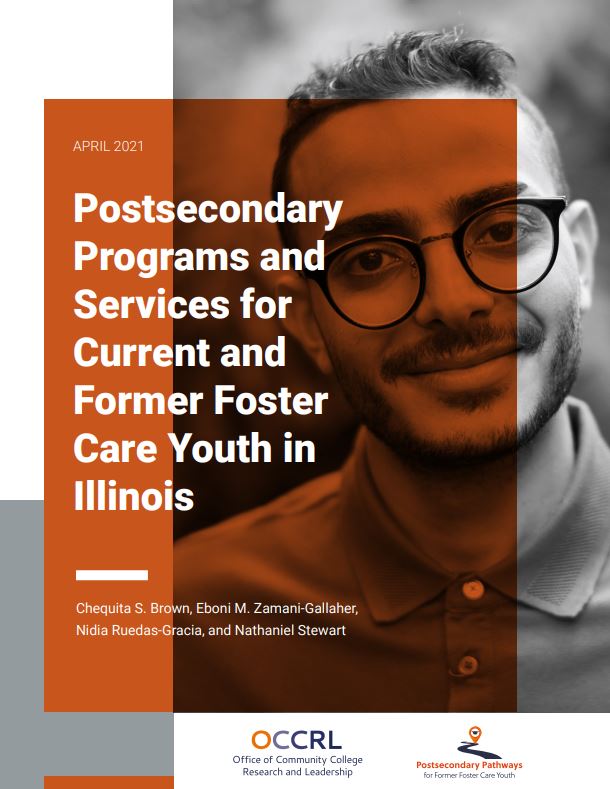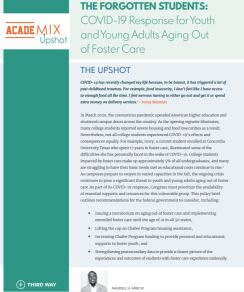
Postsecondary Pathways - for Former Foster Care Youth
This project has been completed and is no longer active.
However, we hope you are able to utilize its resources.
The Postsecondary Pathways for Former Foster Care Youth (PP-FFCY) reflects OCCRL’s commitment to examining and developing postsecondary pathways that support mobility for first-generation, underserved, and minoritized populations, as well as strengthening career pathways to promote seamless transitions from college to careers. This project endeavors to examine postsecondary access, opportunities, and supports for foster youth in Illinois and other states across the county in addressing access and outcomes of FFCY in Career Technical Education (CTE).
Purpose
The Postsecondary Education Pathways for Former Foster Care Youth (PP-FFCY) project is an exploratory study focused on postsecondary pathways for current and former foster youth in Illinois. OCCRL is conducting a comprehensive-needs assessment that provides a descriptive profile of current and former foster youth populations in Illinois; examines postsecondary access, opportunities, and supports for foster youth in Illinois; and addresses disparities in career and technical education (CTE) programs. This project reflects OCCRL’s commitment to examining and developing postsecondary pathways that support mobility for first-generation, underserved, and minoritized populations as well as strengthening and supporting career pathways to promote seamless transitions from college to careers.
Resources
OCCRL aims to increase postsecondary awareness, access, and attainment for current and former foster care youth by providing information on programs and other resources that offer holistic support and services. View the list of postsecondary programs and services.
Strategies to Cultivate a Foster-Friendly Culture on Community College Campuses
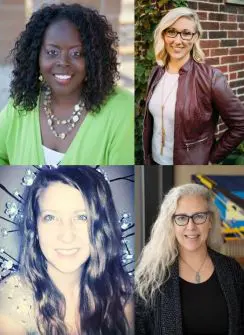 In this episode, Chequita Brown talks with Kate Danielson of the organization Foster Progress, as well as with Anna Wandtke and Tricia Wagner of Rock Valley College in Rockford, Illinois. The group discusses how to cultivate a foster-friendly culture at Illinois community colleges.
In this episode, Chequita Brown talks with Kate Danielson of the organization Foster Progress, as well as with Anna Wandtke and Tricia Wagner of Rock Valley College in Rockford, Illinois. The group discusses how to cultivate a foster-friendly culture at Illinois community colleges.
Navigating College as a Foster Care Alum
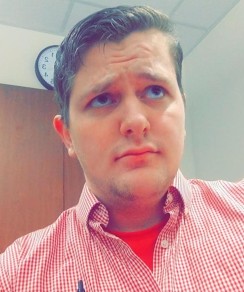 In this episode, OCCRL research assistant Chequita S. Brown talks with Jonathan Stacy, a sophomore at Heartland Community College who is pursuing his studies and a possible career in criminal justice.
In this episode, OCCRL research assistant Chequita S. Brown talks with Jonathan Stacy, a sophomore at Heartland Community College who is pursuing his studies and a possible career in criminal justice.
Listen to the podcast and view the transcript.
Key Elements to Successfully Connecting Foster Care Youth to Educational Resources for Postsecondary Success
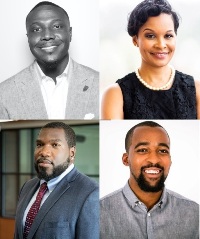 In this episode, Nathaniel Stewart talks with Mauriell Amechi, Regina Gavin Williams, and Blayne Stone Jr. about how the transitions and pathways to postsecondary education are similar and different for Black former foster care students. The scholars also discuss key elements to successfully connect foster care youth to educational resources that help advance the postsecondary education opportunities for this student population.
In this episode, Nathaniel Stewart talks with Mauriell Amechi, Regina Gavin Williams, and Blayne Stone Jr. about how the transitions and pathways to postsecondary education are similar and different for Black former foster care students. The scholars also discuss key elements to successfully connect foster care youth to educational resources that help advance the postsecondary education opportunities for this student population.
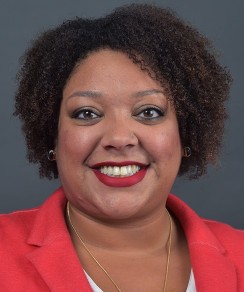
Maddy Day
The Impact of Campus-Based Support Programming on Foster Care Collegians' Postsecondary Access and Retention
In this episode, Chequita Brown of OCCRL talks with Maddy Day about the Fostering Success initiative in Michigan and the impact of campus-based support programming on foster carecollegians' postsecondary access and retention.
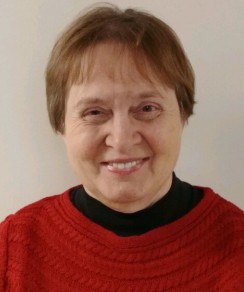
Patricia Palmer
How Youth-in-Care in Illinois Can Access Educational Resources to Pursue a Postsecondary Education
In this episode, OCCRL research assistant Chequita Brown continues the conversation on foster care youth by talking about with Patricia Palmer about accessing available resources in Illinois for youth-in-care who want to pursue a postsecondary education.
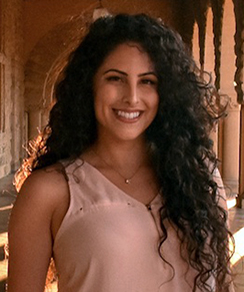
Nidia Ruedas-Gracia
Conceptualizing 'Sense of Belonging' Among Students From Historically Minoritized Racial Groups Within Higher Education
In this episode, Colvin Georges Jr., a research associate at OCCRL, talks with Dr. Nidia Ruedas-Gracia about what it means to have a sense of belonging and discusses her research in this area. They also discuss how a sense of belonging affects college students from historically minoritized racial groups.
Postsecondary Programs and Services for Current and Former Foster Care Youth in California
By Chequita S. Brown, Nidia Ruedas-Gracia, and Eboni M. Zamani-Gallaher
This brief highlights postsecondary programs and services in California that support youth in care, in addition to young adults who are aging out of foster care. Read more.
Tracking College-to-Career Pathways for Foster Youth
By Chequita S. Brown
In this OCCRL Thought Paper, Chequita S. Brown relates how tracking the data of students with foster care experience helps to recognize them as a legitimate student population. She offers recommendations on how to do this and conveys the many obstacles that can hinder the academic and career success of foster youth. Read more.
Black Youth in Foster and the School-Prison Nexus
By Royel Johnson
In this OCCRL Feature Brief, Dr. Royel Johnson argues that the foster care system, and more specifically congregate care facilities, are part and parcel to the enhancement of carceral state power. Read more.
Postsecondary Programs and Services for Current and Former Foster Care Youth in Illinois
By Chequita S. Brown, Eboni Zamani-Gallaher, Nidia Ruedas-Gracia, and Nathaniel M. Stewart
This research brief provides an overview of programs and services that helps strengthen postsecondary pathways for current and former foster youth in Illinois. Read more.
Foster Youth and Basic-Needs Insecurity
By Dra. Nidia Ruedas-Gracia, Chequita S. Brown, Dr. Mauriell Amechi, Dr. Eboni Zamani-Gallaher, and Nathaniel M. Stewart
This article discusses how COVID-19 has intensified the vulnerabilities of foster youth and former foster youth, many of whom are Black, Native American, Alaska Native, and multiracial children who have a higher rate of placement into foster care than White youth (Federal Interagency Forum on Child and Family Statistics, 2016). Read more.
(From the Fall 2020 UPDATE on Research and Leadership)
Exploring Equity in Postsecondary Education
By Heather L. Fox, Eboni M. Zamani-Gallaher
This chapter examines how postsecondary practitioners are encouraged to work collaboratively with child welfare agencies and other community-based organizations to identify and implement culturally responsive supports for former foster youth to promote early academic achievement. Read more.
The Forgotten Students: COVID-19 Response for Youth and Young Adults Aging Out of Foster Care
By Mauriell H. Amechi
This policy brief outlines recommendations for Congress to consider regarding the country's COVID-19 response, in an effort to prioritize the availability of essential supports and resources for youth and young adults who are aging out of foster care. Read more.
Dual Enrollment Equity Through OER, for Underserved Populations in Higher Education
Attending the “OER in Dual Enrollment” webinar was my effort of understanding how OER (open educational resources) is being researched and connected to dual enrollment equity. The “OER in Dual Enrollment: Leveraging Open Educational Resources to Expand Equitable Access” report, prepared by Jennifer Zinth, outlined the webinar. The data analyzed for the study included 11 remote interviews with 19 state and local stakeholders in nine states. The study identified current policies and practices that demonstrate the best lessons learned about the use of OER in dual enrollment (Zinth, 2021).
Zinth (2021) says, “Dual enrollment, also known as concurrent enrollment, dual credit and by other terms, refers to college courses offered to high school students, often for both high school and college credit” (p. 2). Not every dual enrollment program is the same. Programs vary by instructor, course type, and location. Students may take in-person, online, or in-combination courses.
In her report, Zinth (2019) says, “Dual enrollment equity means that the student population in a state’s dual enrollment program mirrors the demographic, socioeconomic and geographic diversity of the state’s overall K-12 student population” (p.2). ExcelinEd Civil Rights Data Collection Analysis (2018) reported that millions of high school students in lower-income communities and communities of color continue not to access college prep courses at the high school level, even though the U.S. Department of Education (2020) reported 82% of public high schools offering ninth- to 12th-graders dual enrollment courses between 2017-2018 (U.S. Department of Education, 2020).
Additionally, one in five high schools do not offer Algebra I or higher, and one in four do not have access to biology, chemistry, or physics. This means 1,370,825 students do not have access to geometry, Algebra II, advanced math, or calculus, and 1,549,273 students do not have access to biology, chemistry, or physics (ExcelEd Civil Rights, 2018). Students who do not have access to these math and science courses are denied the opportunity to take classes that help prepare them for college and gain acceptance to four-year degree-granting institutions and STEM majors.
Zinth (2021) provides key takeaways in her report. One recommendation from stakeholders that stood out to me is that more conversations and involvement need to occur at the state level. Stakeholders suggested providing “state-supported training and a network of support” (p. 10) for institutional staff and faculty to help lessen the resistance of OER use.Power dynamics exist in the U.S. educational system, which is a business and bureaucracy, not a democracy. Therefore, state support is needed to guide the use and benefit of OER for lessening students’ costs and debt
Another recommendation from stakeholders is that more conversations need to be encouraged at state faculty meetings, informing about the barriers and high student debt that keep underserved populations from accessing and completing higher education degrees. Stakeholders say meeting conversations should encourage faculty to think about textbook costs and student debt for all students, not just enrolled college students.
More research is needed to understand how OER benefits dual enrollment equity and underrepresented students who are enrolled at community colleges (Perez et al., 2021). As one of the researchers for the Open Educational Resources project at the Office of Community College and Leadership (OCCRL), I can say that our goal is to assess the need and use of OER at community colleges in Illinois. We research the national and state barriers, trends, and equity practices that use OER to serve historically underrepresented students in higher education. The literature I analyzed in this research area does not clearly define OER’s initiatives but does report what institutions in Illinois are using OER materials and their value for students.
When it comes to underrepresented populations, there is no data to support the advantages of OER helping marginalized students and students with disabilities. Therefore, community colleges are valuable because these institutions serve students of diverse economic and special needs. If OER is a solution for offering students high-quality educational experiences that enhance dual enrollment equity, better teaching practices, inexpensive learning resources, and decreased textbook costs, then, as Zinth (2021) reported, more state-level support and funding need to be applied to OER initiatives. OER needs to be seen as a valuable option for getting underprivileged students from high school to completing postsecondary degrees without high college debt.
References
ExcelinEd Civil Rights Data Collection Analysis. (2018). College and career pathways: equity and access.
Perez, M., Del Real Viramontes, J., Yeo, H. T., Owolabi, N., & Zamani-Gallaher, E. M. (2021, June). Fostering access, affordability, and equity: A primer on the role of open educational resources in Illinois career and technical education. Champaign, IL: Office of Community College Research and Leadership, University of Illinois at Urbana Champaign.
U.S. Department of Education, National Center for Education Statistics. (2020). Dual or concurrent enrollment in public schools in the united states. Washington, D.C: Government Printing Office.
Zinth, J. (2019). Funding for equity: Designing state dual enrollment funding models to close equity gaps. College in High School Alliance.
Zinth, J. (2021). OER in dual enrollment: Leveraging open educational resources to expand equitable access. Midwestern Higher Education Compact and Southern Regional Education Board.
